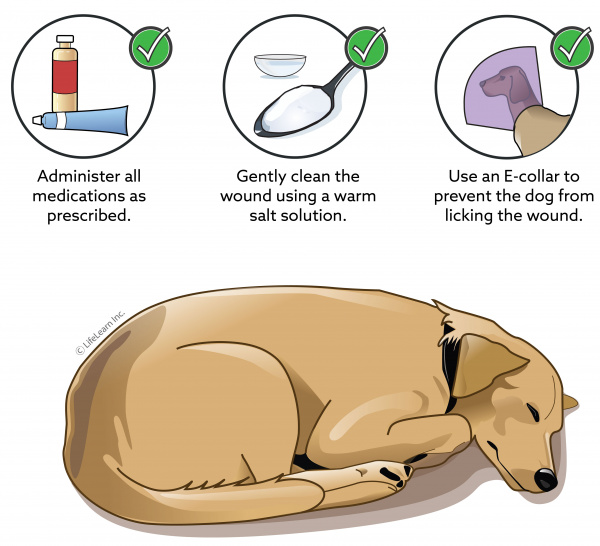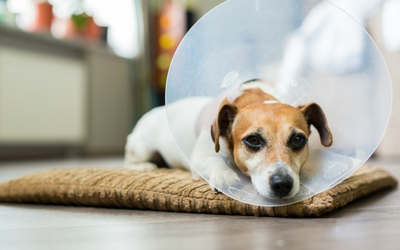What Antiseptic Can You Use on Dogs
My dog has a large open wound and my veterinarian recommended leaving it open to heal rather than repairing it with sutures. Why is this?
Wounds vary according to:
Cause - puncture wounds, abrasions, or lacerations
Location - paws, abdomen, eyes, etc.
Level of contamination - clean (surgical) wounds, contaminated (infected)
Your veterinarian has considered all of these factors when deciding the best way to treat a specific wound. Sometimes the location or the amount of skin loss prevents surgical closure or bandaging (wounds on the face or high up on the leg).
Sometimes, puncture wounds or other trauma force bacteria deep into the tissues. A contaminated wound that is more than a few hours old should never be closed without surgical debridement (removal of all the contaminated or dead tissue), and in some cases this may result in more permanent damage than treating the wound medically and leaving it open to heal.
What will be done for my dog's wound?
Abscesses may be lanced and cleaned under heavy sedation or anesthesia. A latex drain will be placed to prevent the wound from closing too quickly in order to allow proper drainage and prevent the further build-up of infection.
"Wherever possible a wound will be closed and sutured in order to speed healing."
Wherever possible, a wound will be closed and sutured in order to speed healing. However, if there is gross contamination or deep infection present, the wound will be left open for topical treatment and to ensure drainage.
Your veterinarian may need to anesthetize your dog to remove foreign material and dead tissue from the wound. If the wound cannot be surgically closed, your veterinarian may apply a protective bandage if this is possible. Your dog will receive oral or injectable antibiotics (such as amoxicillin-clavulanate or cefazolin).
How will I need to care for this open wound? 
When your pet was discharged from the hospital, you received specific instructions regarding your pet's home care. Some general care guidelines include:
- It is important that the wound and surrounding area is gently cleaned to remove any crusty or sticky debris. This will keep the wound edges clean, reduce the potential for re-infection, and allow new healthy tissue to develop.
- Administer all of the medications as prescribed. Do not discontinue antibiotics for any reason unless you have been specifically instructed to do so by your veterinarian.
- Your dog should not be allowed to lick or chew the open wound. Many dogs will require a protective collar (see handout "Elizabethan Collars in Dogs" for more information) to prevent them from injuring the site.
- It is important to prevent the skin from healing over the wound too quickly. This is particularly important with abscesses that have been lanced and drained surgically. If the wound closes prematurely, the risk of recurrence increases.
How do I prevent the wound from closing too early?
When cleaning the wound, gently massage the surrounding skin to open the wound and promote drainage. You may note some discharge or bleeding when you do this. Note whether it appears to be infected (a thick or colored discharge) or if it is a clear thin fluid. You should remove or allow either type of discharge to drain away. If the discharge continues to be bloody, green, or yellow for several consecutive days, contact your veterinarian for instructions.
What should I clean the wound with?
Warm tap water is recommended for cleaning most wounds. Warm saline (salt solution) may also be used. This may be made by adding approximately one level teaspoonful (5 mL) of salt (or Epsom salts) to two cups (500 mL) of water. In some cases, your veterinarian may recommend using a dilute cleansing solution of chlorhexidine, a surgical soap, or an iodine solution to help remove debris.
"DO NOT use soaps, shampoos, rubbing alcohol, hydrogen peroxide, herbal preparations, tea tree oil, or any other product to clean an open wound."
DO NOT use soaps, shampoos, rubbing alcohol, hydrogen peroxide, herbal preparations, tea tree oil, or any other product to clean an open wound, unless specifically instructed to do so by your veterinarian. Some of these products are toxic if taken internally, while others can actually delay healing.
Can I not use mild antiseptics?
Your veterinarian may prescribe antibiotics or a suitable antibiotic cream to apply to the wound. Since animals tend to lick and chew at wounds, inadvertently swallowing medications that are applied topically, or disinfectants and antiseptics intended for human use are rarely suitable for use in animals.
What should I do if my dog tries to lick the wound? 
Many people have the mistaken belief that dog's saliva is somehow antiseptic. This is far from the truth, especially when one considers how dogs groom themselves or greet each other. A dog will instinctively lick at a wound, but this can seriously delay healing. Therefore, you must prevent this by any means possible. Elizabethan collars are the most commonly used protective device. Other options, depending on the location of the wound, include covering the wound with a bandage, a stockinette, a dog coat, or a t-shirt.
What about pain medications?
Your veterinarian will prescribe appropriate medications to relieve pain and discomfort. Once a wound has begun to heal, it is no longer as painful. Your veterinarian will assess the individual situation and determine the most appropriate medications for your dog. Pain medications most typically prescribed are non-steroidal anti-inflammatory drugs (NSAIDs) such as meloxicam (Rheumocam, Metacam®), deracoxib (Deramaxx®), or carprofen (Rimadyl®).
What Antiseptic Can You Use on Dogs
Source: https://vcahospitals.com/know-your-pet/care-of-open-wounds-in-dogs
0 Response to "What Antiseptic Can You Use on Dogs"
Post a Comment